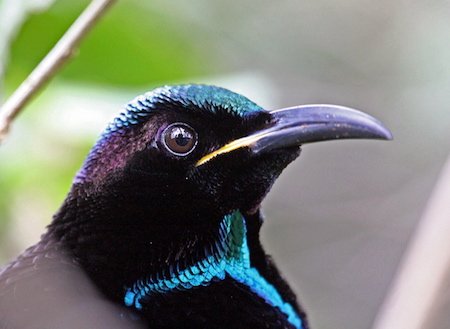Paradisaeidae – Birds-of-paradise

The birds-of-paradise are members of the family Paradisaeidae of the order Passeriformes. The majority of species are found in eastern Indonesia, Papua New Guinea, and eastern Australia. The members of this family are perhaps best known for the plumage of the males of the sexually dimorphic species (the majority), in particular the highly elongated and elaborate feathers extending from the beak, wings, tail or head. For the most part they are confined to dense rainforest habitat. The diet of all species is dominated by fruit and to a lesser extent arthropods. The birds-of-paradise have a variety of breeding systems, ranging from monogamy to lek-type polygamy.
A number of species are threatened by hunting and habitat loss.
They range in size from the King Bird-of-paradise at 50 g (1.8 oz) and 15 cm (5.9 in) to the Curl-crested Manucode at 44 cm (17 in) and 430 g (15 oz). The male Black Sicklebill, with its long tail, is the longest species at 110 cm (43 in). In most species, the tails of the males are larger and longer than the female, the differences ranging from slight to extreme. The wings are rounded and in some species structurally modified on the males in order to make sound. There is considerable variation in the family with regard to bill shape. Bills may be long and decurved, as in the sicklebills and riflebirds, or small and slim like the Astrapias. As with body size bill size varies between the sexes, although species where the females have larger bills than the male are more common, particularly in the insect eating species.
Plumage variation between the sexes is closely related to breeding system. The manucodes and paradise-crow, which are socially monogamous, are sexually monomorphic. So are the two species of Paradigalla, which are polygamous. All these species have generally black plumage with varying amounts of green and blue iridescence. The female plumage of the dimorphic species is typically drab to blend in with their habitat, unlike the bright attractive colours found on the males. Younger males of these species have female-like plumage, and sexual maturity takes a long time, with the full adult plumage not being obtained for up to seven years. This affords the younger males the protection from predators of more subdued colours, and also reduces hostility from adult males.
The majority of birds-of-paradise live in tropical forests, including rainforest, swamps and moss forest, nearly all of them solitary tree dwellers. Several species have been recorded in coastal mangroves. The southernmost species, the paradise riflebird of Australia, lives in sub-tropical and temperate wet forests. As a group the manucodes are the most plastic in their habitat requirements, with in particular the glossy-mantled manucode inhabiting both forest and open savanna woodland. Mid-montane habitats are the most commonly occupied habitat, with thirty of the forty species occurring in the 1000–2000 m altitudinal band.
The diet of the birds-of-paradise is dominated by fruit and arthropods, although small amounts of nectar and small vertebrates may also be taken. The ratio of the two food types varies by species, with fruit predominating in some species, and arthropods dominating the diet in others. The ratio of the two will affect other aspects of the behaviour of the species, for example frugivorous species tend to feed in the forest canopy, whereas insectivores may feed lower down in the middle storey. Frugivores are more social than the insectivores, which are more solitary and territorial.
Most species have elaborate mating rituals, with the Paradisaea species using a lek-type mating system. Others, such as the Cicinnurus and Parotia species, have highly ritualised mating dances. Males are polygamous in the sexually dimorphic species, but monogamous in at least some of the monomorphic species. Hybridisation is frequent in these birds, suggesting the polygamous species of bird of paradise are very closely related despite being in different genera.
Most authorities agree that there are 41 species of Birds-of-Paradise that inhabit New Guinea, Australia and islands in the family Paradisaeidae. They are:
Paradise-crow Lycocorax pyrrhopterus
Glossy-mantled Manucode Manucodia ater
Jobi Manucode Manucodia jobiensis
Crinkle-collared Manucode Manucodia chalybatus
Curl-crested Manucode Manucodia comrii
Trumpet Manucode Phonygammus keraudrenii
Long-tailed Paradigalla Paradigalla carunculata
Short-tailed Paradigalla Paradigalla brevicauda
Arfak Astrapia Astrapia nigra
Splendid Astrapia Astrapia splendidissima
Ribbon-tailed Astrapia Astrapia mayeri
Princess Stephanie’s Astrapia Astrapia stephaniae
Huon Astrapia Astrapia rothschildi
Western Parotia Parotia sefilata
Carola’s Parotia Parotia carolae
Bronze Parotia Parotia berlepschi
Lawes’s Parotia Parotia lawesii
Eastern Parotia Parotia helenae
Wahnes’s Parotia Parotia wahnesi
King of Saxony Bird-of-paradise Pteridophora alberti
Superb Bird-of-paradise Lophorina superba
Paradise Riflebird Ptiloris paradiseus
Victoria’s Riflebird Ptiloris victoriae
Magnificent Riflebird Ptiloris magnificus
Growling Riflebird Ptiloris intercedens
Black Sicklebill Epimachus fastuosus
Brown Sicklebill Epimachus meyeri
Black-billed Sicklebill Drepanornis albertisi
Pale-billed Sicklebill Drepanornis bruijnii
Magnificent Bird-of-paradise Diphyllodes magnificus
Wilson’s Bird-of-paradise Diphyllodes respublica
King Bird-of-paradise Cicinnurus regius
Standardwing Semioptera wallacii
Twelve-wired Bird-of-paradise Seleucidis melanoleucus
Greater Bird-of-paradise Paradisaea apoda
Raggiana Bird-of-paradise Paradisaea raggiana
Lesser Bird-of-paradise Paradisaea minor
Goldie’s Bird-of-paradise Paradisaea decora
Red Bird-of-paradise Paradisaea rubra
Emperor Bird-of-paradise Paradisaea guilielmi
Blue Bird-of-paradise Paradisaea rudolphi
-
Victoria's Riflebird Ptiloris victoriae
Species AccountSound archive and distribution map -
Victoria's Riflebird Ptiloris victoriae
Species AccountThe Victoria’s riflebird (Ptiloris victoriae) also known as the duwuduwu to the Yidinji people, is a bird-of-paradise endemic to the Atherton Tableland region of northeastern Queensland, Australia where it resides year-round.
-
Number of bird species: 41
-
The Birds of Paradise
by Clifford B Frith & Bruce M Beehler [Illustrated by William T Cooper] OUP 1998 ISBN: 0198548532 Buy this book from NHBS.com
